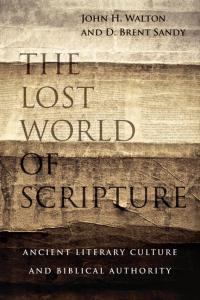 In the next chapter of The Lost World of Scripture John Walton and D. Brent Sandy emphasize the oral origins of the New Testament. The written text preserved for us is essential for the church today. Neither John Walton nor Brent Sandy deny this. The recorded witness of the early church and the eyewitnesses to the life, death, resurrection, and ascension of Jesus are authoritative for the church. They guide our understanding of orthodox Christian faith. But the form the written texts take reflect their origin in an oral culture where memories were first preserved as oral tradition and only later written down.
In the next chapter of The Lost World of Scripture John Walton and D. Brent Sandy emphasize the oral origins of the New Testament. The written text preserved for us is essential for the church today. Neither John Walton nor Brent Sandy deny this. The recorded witness of the early church and the eyewitnesses to the life, death, resurrection, and ascension of Jesus are authoritative for the church. They guide our understanding of orthodox Christian faith. But the form the written texts take reflect their origin in an oral culture where memories were first preserved as oral tradition and only later written down.
Brent and John summarize key points (pp. 244-245) (1) The earliest records of the life and ministry of Jesus were oral; (2) The oral texts of the gospel were the foundation of the early church; (3) Oral texts were foundational for the written Gospels; and (4) Many of the variants among the Gospel records arc best accounted for by frequent retellings of the oral texts.
 Even the letters of Paul likely originated in the context of his oral preaching and teaching and in community with his fellow travelers and coworkers. They carry Paul’s authority as an apostle, but may do so as compositions from others as coauthors. Brent and John point out that several of the letters indicate that they come from one or more people. 1 Corinthians starts Paul, called to be an apostle of Christ Jesus by the will of God, and our brother Sosthenes. (1:1). This may indicate that Sosthenes was not merely a travelling companion – but contributed actively to the formation of the letter. In general companions are acknowledged through greetings at the end of the letter, not in the initial salutation. (1 Corinthians ends with such greetings from Aquila, Priscilla and all the brothers and sisters.) Galatians is not as specific but also indicates the letter is from Paul and those with him. Although Brent and John don’t want to be dogmatic about possible contributions of Paul’s fellow travelers or scribes, they point out that it is also unwise to exclude them from the composition process. The possibility of multiple contributors does not undermine the authority of the letters or the work of the Holy Spirit in guiding the composition and preservation.
Even the letters of Paul likely originated in the context of his oral preaching and teaching and in community with his fellow travelers and coworkers. They carry Paul’s authority as an apostle, but may do so as compositions from others as coauthors. Brent and John point out that several of the letters indicate that they come from one or more people. 1 Corinthians starts Paul, called to be an apostle of Christ Jesus by the will of God, and our brother Sosthenes. (1:1). This may indicate that Sosthenes was not merely a travelling companion – but contributed actively to the formation of the letter. In general companions are acknowledged through greetings at the end of the letter, not in the initial salutation. (1 Corinthians ends with such greetings from Aquila, Priscilla and all the brothers and sisters.) Galatians is not as specific but also indicates the letter is from Paul and those with him. Although Brent and John don’t want to be dogmatic about possible contributions of Paul’s fellow travelers or scribes, they point out that it is also unwise to exclude them from the composition process. The possibility of multiple contributors does not undermine the authority of the letters or the work of the Holy Spirit in guiding the composition and preservation.
The major point that John and Brent make is that modern emphasis on texts and authorship has led us to misunderstand the nature of the formation of the New Testament and the cultural influences that shaped the text we have. Source criticism, form criticism, and redaction criticism all emphasize written documents and texts. Most arguments for the existence of Q, L, and M arise from specific assumptions about the importance of written texts. Fundamentalist views of inspiration also emphasize modern forms for written compositions and compilations (John and Brent don’t put it exactly like this – but it seems evident to me). We are embedded in a literary culture such that both skeptical and confessional readers of scripture start with expectations that would have been foreign to the first and second century church.
Imposing literary expectations developed over the last half millennia on the early church would be comparable to imposing expectations from the age of the internet on scholarly activity of the 1800’s (or even 1900’s). It is incumbent on us as later readers to endeavor to look through first century eyes. We cannot expect them to conform to 21st century expectation.
Brent and John conclude:
Understanding the composition of the New Testament in the context of orality is an almost impossible undertaking for modern Western minds. Not only is evidence limited regarding specific phases of the process, but it’s also difficult to peel off centuries of layers of textuality and contemplate a world of wheelless automobiles and textless texts. (p. 250)
The Holy Spirit guided the church in the formation of the New Testament, but not necessarily in the manner we, in our day and age, would assume or expect. Nonetheless the message comes through.
The early church may not have realized the extent to which they were under divine guidance and authority as they recounted oral texts of the gospel night after night, as they preached the gospel from city to city and as they recorded divine truth in written Gospels and letters to churches, But from God’s perspective, there was a sense that they were doing even greater works than Jesus himself. When their oral texts became written texts, we can infer that the same revelational deposit and matrix of theological beliefs applied to the written forms.
… Both [oral and written texts] were reliable representations of divine truth, and the early scribes making copies of manuscripts felt free to draw from oral and written traditions. (p. 251)
Bottom line: Many of the so-called “problems” (discrepancies in detail) in the New Testament are not problems at all – but issues created by erroneous expectations of Bible we have before us.
How do we impose our expectations on Scripture?
How do we best listen to the message of the New Testament?
If you wish to contact me directly you may do so at rjs4mail[at]att.net
If interested you can subscribe to a full text feed of my posts at Musings on Science and Theology.















